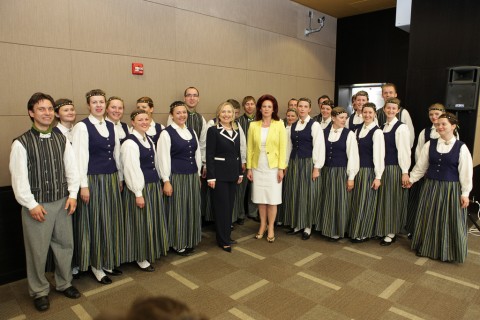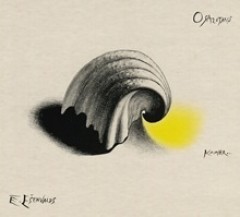
Of all the difficult professions to hold in Latvia, one of the most difficult is being a professional musician. Between giving concerts, teaching students both privately and at the Latvian Academy of Music, recording albums – often without major financial reward – one must truly be an exceptional individual to be able to find time for all of this and still enjoy their work.
Some musicians do even more – such as countertenor Sergejs Jēgers – who even finds time to run a charity. Yet Jēgers found the time to record an album of sacred songs, mainly from the Baroque era, entitled Ave Maria, released in late 2011. All songs are backed by organist Diāna Jaunzeme.
This is now Jēgers’ fourth solo album – after his debut in 2006 with Ave Musica, a collection of baroque era songs, followed by a duet album in 2007 with saxophonist Artis Gāga entitled Duende, and interpretations of Latvian folk songs in 2009 accompanied by Sinfonietta Rīga – Dziesmiņās remdējos.
Quite coincidentally, Inese Galante fans that picked up her latest release, The Soul of Rīga (2011), will recognize a number of these songs, as some of them appear on both albums. It is actually quite interesting to hear and compare the two interpretations, particularly because both albums feature a singer accompanied by organ. Additionally, both records were recorded in the Rīga Cathedral, reaffirming the church’s status as the premiere venue for sacred recordings. In fact, in the liner notes, Jēgers notes that Galante suggested and inspired some of the selections on this CD.
Jēgers is clearly most at home singing Baroque melodies, and this collection is another testament to that – listeners will find both well-known and obscure songs on this collection. Perhaps the best known Ave Maria is the version by J. S. Bach and Ch. Gounod, which is also the first track on this CD – even though it is well known, Jēgers brings the necessary reverence and spirituality to his rendition, making is a particularly memorable one.
However, not all the songs are Baroque era tunes – there are a number of songs from later eras. These songs, such as Saint-Saëns’ Ave Maria and Franck’s Panis angelicus are also highlights of this collection. Panis angelicus being such a well-known melody that it can often times be difficult to bring something new to the song or to do the song justice, however Jēgers’ soaring voice brings new life to these works.
The most recent work on the CD – the Ave Maria by Russian guitarist and composer V. Vavilov, is perhaps one of the more interesting and enjoyable songs on the album. Though it is a “20th century” Ave Maria, the vocal lines and accompaniment certainly sound as if they were from the Baroque era or earlier.
One of my favorites on the album is the version of “What Power art Thou” by Henry Purcell (from the opera “King Arthur”), which, though it was composed in the late 17th century, its chromatic and staccato-like melody give it a very modern sound.
The liner notes have brief biographies of Jēgers and Jaunzeme in Latvian and English.
Ave Maria is yet another memorable release from Jēgers, who demonstrates, once again, his immense talent in performance and interpretation. This could very well be considered a companion recording to his first solo CD – Ave Musica, as both feature Jēgers performing (mostly) Baroque era sacred works. It is always intriguing to find out what Jēgers plans for his next recording – as both Duende and Dziesmiņās remdējos were both quite different and original. The voice of Jēgers, along with the organ played by Jaunzeme, make for a particularly vivid and enjoyable listen.
More information can be found on the artist’s website:www.sergejsjegers.lv
Details
Ave Maria
Sergejs Jēgers
Latvijas koncerti, 2011
Track listing:
1. J. S. Bach / Ch. Gounod- Ave Maria
2. H. Purcell – Fairest Isle (from King Arthur)
3. G. F. Händel – Almirena’s aria Lascia ch’io pianga from the opera Rinaldo
4. H. Purcell – Music for a While
5. G. F. Händel – Dignare from Dettingen Te Deum
6. P. Tosti – Ave Maria
7. Anonymous 19th century author – Pietà, Signore
8. C. Saint-Saëns – Ave Maria
9. C. Franck – Panis angelicus
10. G. Fauré – Pie Jesu from Requiem
11. Unknown 18th century author – Caro mio ben
12. G. F. Händel – Xerxes’ aria Ombra mai fu from Xerxes
13. H. Purcell – What Power Art Thou from King Arthur
14. G. Caccini – Amarilli, mia bella
Where to buy
Purchase Ave Maria from BalticShop.
Note: Latvians Online receives a commission on purchases.





